|
BRICKS
& MORTAR - CARRIAGE
- DRAINAGE
- FACILITIES
- FILTRATION
- GLASS
& PAINT - GANTRY
- GIMBALS
- HATCHES
- HYDRODYNAMICS
HISTORY - INSTRUMENTS -
LABORATORY
- LAMINATING
- LOGISTICS
- OUR
TEST TANK - PROOFING
- REVIEWS
- SCREEDING
- SEAVAX
TEST VIDEOS - SLUICE
GATE - SOLAR
BATTERIES - WAVE
MAKING - WIND
MACHINE
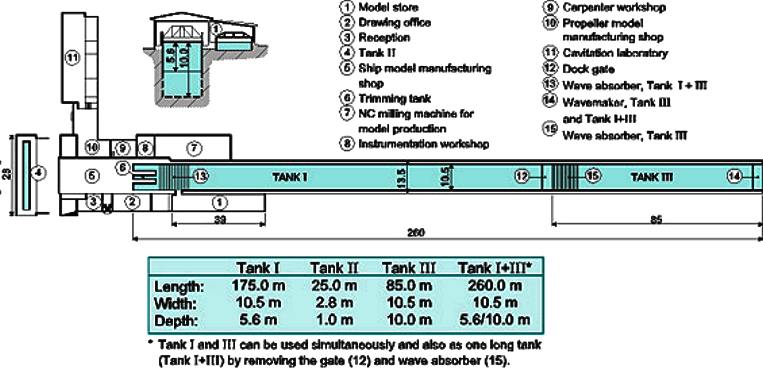
INTRODUCTION
A ship model basin is a physical basin or
long water tank used to carry out hydrodynamic tests with ship models, for the purpose of designing a new (full sized) ship, or refining the design of a ship to improve the ship's performance at sea. It can also refer to the organization (often a company) that owns and operates such a facility.
A ship model basin company is an engineering firm that acts as a contractor to the relevant shipyards, and provides hydrodynamic model tests and numerical calculations to support the design and development of ships and offshore structures.
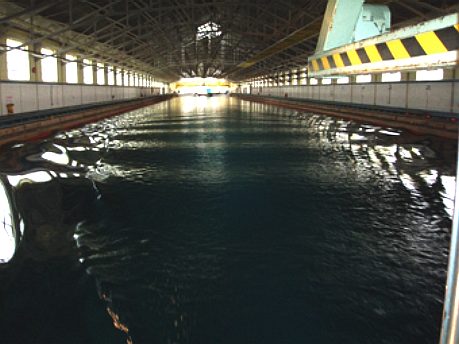
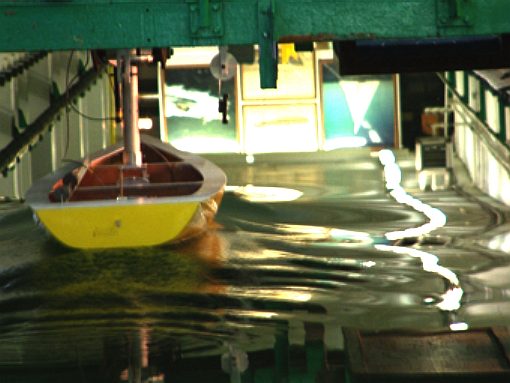
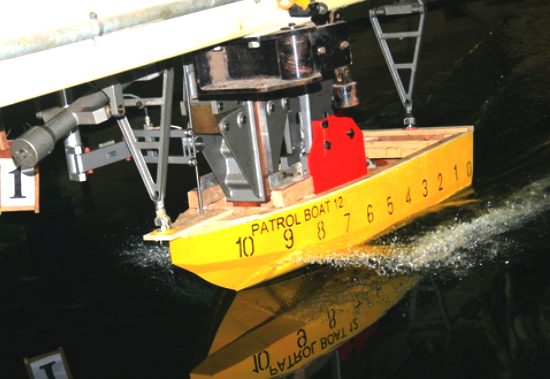
TEST
FACILITIES
The hydrodynamic test facilities present at a model basin site include at least a towing tank and a cavitation tunnel and workshops. Some ship model basins have further facilities such as a maneuvering and
sea-keeping basin and an ice tank.
Towing tank
A towing tank is a basin, several meters wide and hundreds of metres long, equipped with a towing carriage that runs on two rails on either side. The towing carriage can either tow the model or follow the self-propelled model, and is equipped with computers and devices to register or control, respectively, variables such as speed, propeller thrust and torque, rudder angle etc. The towing tank serves for resistance and propulsion tests with towed and self-propelled ship models to determine how much power the engine will have to provide to achieve the speed laid down in the contract between shipyard and ship owner. The towing tank also serves to determine the maneuvering behaviour in model scale. For this, the self-propelled model is exposed to a series of zig-zag maneuvers at different rudder angle amplitudes. Post-processing of the test data by means of system identification results in a numerical model to simulate any other maneuver like Dieudonné spiral test or turning circles. Additionally, a towing tank can be equipped with a PMM (planar motion mechanism) or a CPMC (computerized planar motion carriage) to measure the hydrodynamic forces and moments on ships or submerged objects under the influence of oblique inflow and enforced motions. The towing tank can also be equipped with a wave generator to carry out
sea-keeping tests, either by simulating natural (irregular) waves or by exposing the model to a wave packet that yields a set of statistics known as response amplitude operators (acronym RAO), that determine the ship's likely real-life sea-going behavior when operating in seas with varying wave amplitudes and frequencies (these parameters being known as sea states). Modern
sea-keeping test facilities can determine these RAO statistics, with the aid of appropriate computer hardware and software, in a single test.
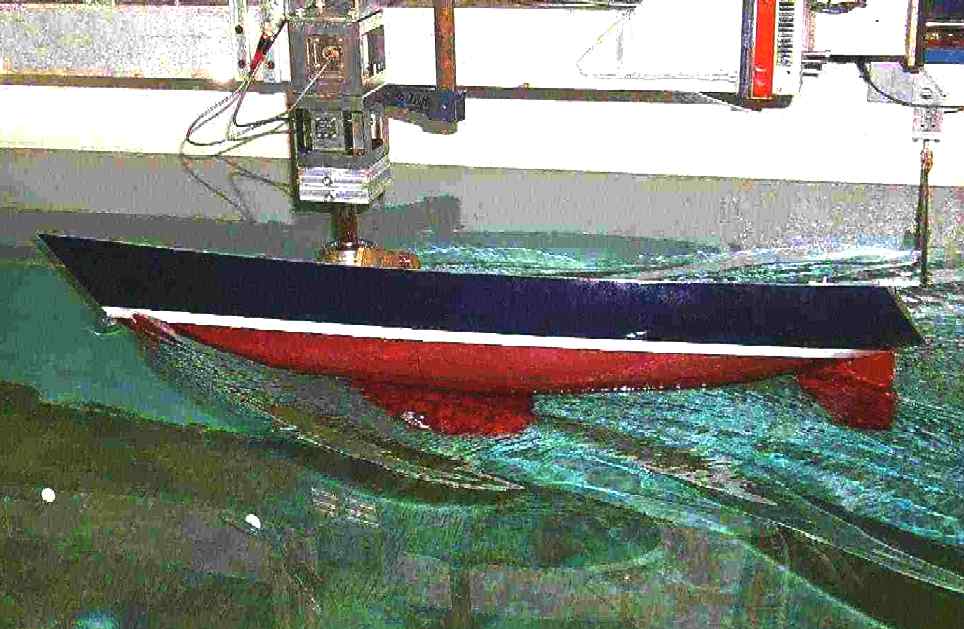
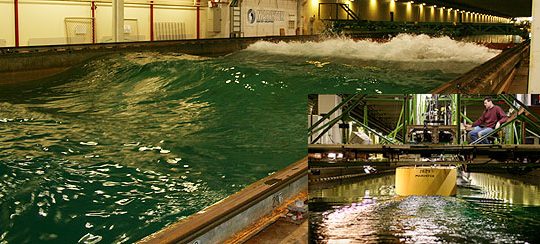
Cavitation tunnel
A cavitation tunnel is used to investigate propellers. This is a vertical water circuit with large diameter pipes. At the top, it carries the measuring facilities. A parallel inflow is established. With or without a ship model, the propeller, attached to a dynamometer, is brought into the inflow, and its thrust and torque is measured at different ratios of propeller speed (number of revolutions) to inflow velocity. A stroboscope synchronized with the propeller speed serves to visualize cavitation as if the cavitation bubble would not move. By this, one can observe if the propeller would be damaged by cavitation. To ensure similarity to the full-scale propeller, the pressure is lowered, and the gas content of the water is controlled.
Workshops
Ship model basins manufacture their ship models from wood or paraffin with a computerized milling machine. Some of them also manufacture their model propellers. Equipping the ship models with all drives and gauges and manufacturing equipment for non-standard model tests are the main tasks of the workshops.
Maneuvering and sea-keeping basin
This is a test facility that is wide enough to investigate arbitrary angles between waves and the ship model, and to perform maneuvers like turning circles, for which the towing tank is too narrow. However, some important maneuvers like the spiral test still require even more space and still have to be simulated numerically after system identification.
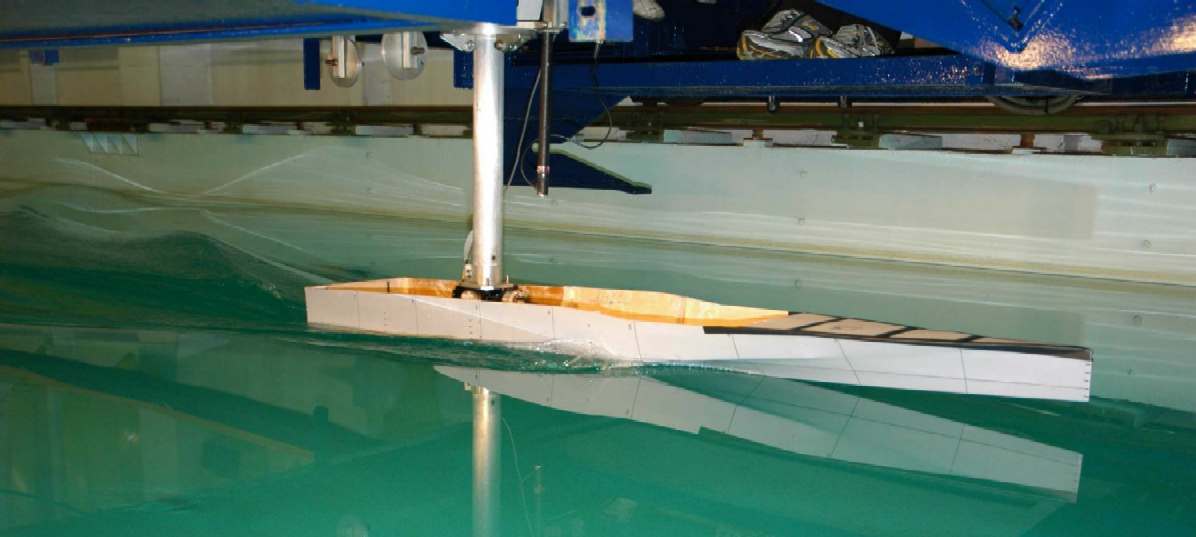
Ice tank
An ice tank is used to develop ice breaking vessels, this tank fulfills similar purposes as the towing tank does for open water vessels. Resistance and required engine power as well as maneuvering behaviour are determined depending on the ice thickness. Also ice forces on offshore structures can be determined. Ice layers are frozen with a special procedure to scale down the ice crystals to model scale.
Software
Additionally, these companies or authorities have CFD software and experience to simulate the complicated flow around ships and their rudders and propellers numerically. Today's state of the art does not yet allow software to replace model tests in their entirety by CFD calculations. One reason, but not the only one, is that elementization is still expensive. Also the lines design of some of the ships is carried out by the specialists of the ship model basin, either from the beginning or by optimizing the initial design obtained from the shipyard. The same applies to the design of propellers.
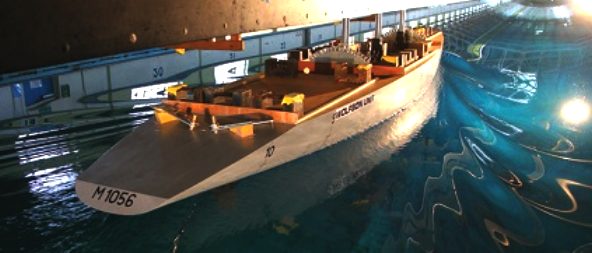
Examples
The ship model basins worldwide are organized in the ITTC (International Towing Tank Conference) to standardize their model test procedures.
Some of the most significant ship model basins are:-
*
The David Taylor Model Basin and the Davidson Laboratory at Stevens Institute of Technology in the United
States,
*
The High Speed Towing Tank facility at Naval Science and Technological Labs at Vizag India,
*
The Institute for Ocean Technology in St. Johns, Canada,
*
FORCE Technology in Lyngby, Denmark,
*
SSPA, in Gothenburg, Sweden,
*
The Maritime Research Institute Netherlands (MARIN) in Wageningen, the Netherlands,
*
The INSEAN in Rome, Italy, the SVA Potsdam in Potsdam,
*
The HSVA in Hamburg, Germany,
*
The "Bassin d'essai des carčnes" in Val de Reuil , France and
*
CEHIPAR in Madrid, Spain, CTO S.A. in Gdansk, Poland
LINKS
https://www.federalregister.gov/articles/2013/03/27/2013-07155/navigation-safety-advisory-council
http://www.regulations.gov/#!home
http://www.law.cornell.edu/uscode/text/33/2073
http://faca-members.findthedata.org/d/dir/DHS/Navigation-Safety-Advisory-Council
http://ag-companies.blogspot.co.uk/2013/03/uscg-navigation-safety-advisory-council.html
https://homeport.uscg.mil/
http://www.uscg.mil/proceedings/
http://www.navcen.uscg.gov/
http://www.uscg.mil/
http://www.usna.edu/Users/naome/phmiller/usna1.html
http://www.sintef.no/home/MARINTEK-old/Laboratories-at-MARINTEK/Ship-Model-Tank/
http://www.flixya.com/photo/2445374/Testing-ship-models
Van-oossanen-associates-fast-tank-tests-for-the-fdhf-corresponding-full-scale-speed-of-24-knots
http://teamtarka.co.uk/2009/11/
http://www.superyachttimes.com/editorial/48/article/id/8659

Solarnavigator
is to be the flagship demonstrator of a new COLREG
compliant integrated navigation system, allowing positional monitoring
and data sharing between
ships and shore, ship to ship and shore to shore, on a comprehensive
basis both nationally and internationally. Contact
Bluebird Marine
Systems Ltd., or Max
Energy Ltd. for details.
BRICKS
& MORTAR - CARRIAGE
- DRAINAGE
- FACILITIES
- FILTRATION
- GLASS
& PAINT - GANTRY
- GIMBALS
- HATCHES
- HYDRODYNAMICS
HISTORY - INSTRUMENTS -
LABORATORY
- LAMINATING
- LOGISTICS
- OUR
TEST TANK - PROOFING
- REVIEWS
- SCREEDING
- SEAVAX
TEST VIDEOS - SLUICE
GATE - SOLAR
BATTERIES - WAVE
MAKING - WIND
MACHINE
|







